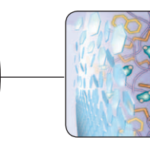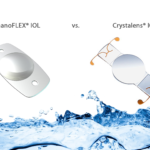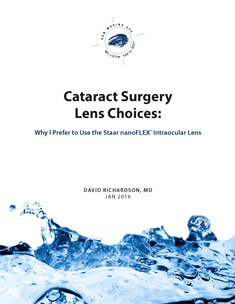Those who choose to have cataract surgery with a traditional monofocal intraocular lens (IOL) will need to wear spectacles for most (if not all) activities. This is because monofocal IOLs are able to provide clear focus for objects at one distance, and one distance only. If objects far away are clear after cataract surgery then everything that is close up will be blurry without spectacles.
The Staar nanoFLEX® IOL, however, is capable of providing a range of vision without the need for spectacles. In general, those who choose to have the Staar nanoFLEX® IOL implanted at the time of cataract surgery are able to see objects that range from far away to about arm’s length. The majority of our daily activities are spent interacting with objects in this range (e.g. cooking, gardening, shopping, working on the computer). As such, choosing the Staar nanoFLEX® IOL can result in significant reduction in the need to wear spectacles after cataract surgery.
The range of vision possible with cataract surgery using the Staar nanoFLEX® IOL is impressive, but not complete. It is often still necessary to wear readers to clearly see objects closer than arm’s length. However, for those who need cataract surgery in both eyes it is possible to extend this range of vision even further by using a technique called “Blended Vision”.
“Blended Vision” with the Staar nanoFLEX® Intraocular Lens
In order to understand the benefits of “Blended Vision” with the Staar nanoFLEX® intraocular lens (IOL) one must first understand what “monovision” is.
Monovision

One eye is set for good near vision
Monovision is a term most commonly used when fitting contact lenses. Rather than correct both eyes for distance, one eye is set for good near vision. Given some time to adapt, many people are able to learn to “switch” their attention from one eye to the other depending upon the task. There are some downsides, however. Not everyone is able to tolerate full monovision and even those who do lose stereopsis (the ability to see in 3D) while they are wearing the contact lenses.
With contact lenses, if you don’t like them you can simply take them out. No big deal. When an intraocular lens (IOL) is placed in the eye during cataract surgery, however, the only way to get it out is to return to the operating room. Thus, full monovision is seldom recommended at the time of cataract surgery unless an individual has previously enjoyed successful contact lens monovision.
“Mini-monovision”

One eye is set for distance vision focus
“Mini-monovision” was developed to address the concern that not everyone can tolerate “full” monovision. Essentially, mini-monovision involves setting the focus of one eye at distance and the other eye at “intermediate” (arm’s length). As the power difference between eyes is rather small most everyone tolerates this well. The increased tolerability, however, comes at a price: reduced range of vision compared to full monovision. When standard monofocal IOLs are implanted at the time of cataract surgery it is still necessary to use reading glasses for everything closer than arm’s length.
It is possible, however, to expand this range of vision with a further modification of mini-monovision called “Blended Vision”.
“Blended Vision”

Two eyes are set for greater range of vision
“Blended Vision”, is generally used to describe “mini-monovision” with the use of a pseudo-accommodating intraocular lens (IOL). Pseudo-accommodating IOLs (such as the Staar nanoFLEX® IOL) provide for a range of good vision on their own after cataract surgery. Combining mini-monovision with the Staar nanoFLEX® IOL results in a greater range of vision than either mini-monovision or the Staar nanoFLEX® IOL could provide on their own with little extra risk or downside.
As with mini-monovision, Blended Vision tends to be more forgiving than true monovision in terms of one’s ability to tolerate the difference between eyes. In general, Blended Vision extends the near range of vision possible without spectacles from arm’s length to about 16 inches. This provides acceptable near vision for almost all daily vision needs after cataract surgery.
Why I Prefer Blended Vision with the Staar nanoFLEX® Intraocular Lens
The near focus point of Blended Vision is still not as close as that of traditional monovision so “readers” may be necessary for small or low contrast print (especially in low light situations) closer than 16-18 inches from the eyes. Despite this likely need for occasional spectacle correction, I prefer blended vision over full monovision for the following reasons:
![]() It is difficult to properly test patients with cataracts for tolerability of full monovision prior to cataract surgery. By definition, anyone with a significant cataract is going to have blurred vision prior to surgery. The brain has the ability to suppress vision from the more blurred eye. As such, there is no way to know whether a trial of monovision performed prior to cataract surgery was truly tolerated or if the brain was just suppressing the blurred image. If not tolerated after cataract surgery then an IOL exchange would likely be needed. Yet, almost everyone tolerates mini-monovision so testing (which is of limited value anyway) is not necessary to predict a satisfactory outcome with Blended Vision.
It is difficult to properly test patients with cataracts for tolerability of full monovision prior to cataract surgery. By definition, anyone with a significant cataract is going to have blurred vision prior to surgery. The brain has the ability to suppress vision from the more blurred eye. As such, there is no way to know whether a trial of monovision performed prior to cataract surgery was truly tolerated or if the brain was just suppressing the blurred image. If not tolerated after cataract surgery then an IOL exchange would likely be needed. Yet, almost everyone tolerates mini-monovision so testing (which is of limited value anyway) is not necessary to predict a satisfactory outcome with Blended Vision.
![]() With mini-monovision, the “near” eye is targeted for intermediate vision at the time of cataract surgery. When combined with a pseudo-accommodating IOL such as the Staar nanoFLEX® IOL the range of vision generally extends from arm’s length to about 16” from the eyes. With full monovision, however, there is often no functional intermediate vision (which in this age of computers can be exceedingly frustrating). Thus, mini-monovision with a pseudo-accommodating IOL (“Blended Vision”) has the potential to give a fuller range of vision after cataract surgery than can traditional monovision using a standard monofocal IOL.
With mini-monovision, the “near” eye is targeted for intermediate vision at the time of cataract surgery. When combined with a pseudo-accommodating IOL such as the Staar nanoFLEX® IOL the range of vision generally extends from arm’s length to about 16” from the eyes. With full monovision, however, there is often no functional intermediate vision (which in this age of computers can be exceedingly frustrating). Thus, mini-monovision with a pseudo-accommodating IOL (“Blended Vision”) has the potential to give a fuller range of vision after cataract surgery than can traditional monovision using a standard monofocal IOL.
Limitations of Blended Vision with the Staar nanoFLEX® Intraocular Lens
Currently, there is no FDA approved intraocular lens (IOL) that can provide a full range of spectacle-free vision after cataract surgery. This statement applies to multifocal IOLs, the Crystalens® IOL, and the Staar nanoFLEX® IOL using Blended Vision. There is simply no multifocal or pseudo-accommodating IOL on the market today that can come close to the clarity and accommodation of a healthy 20 year old eye. Anyone who is expecting such a result is bound to be disappointed.
I generally tell my patients who choose the Staar nanoFLEX® blended vision option that spectacles may be required for “the extremes” of vision. These include the following:
- very small print (such as that seen on medicine bottle labels)
- viewing objects closer than 16 inches from the eyes
- reading in low light
- night driving








Leave a Reply